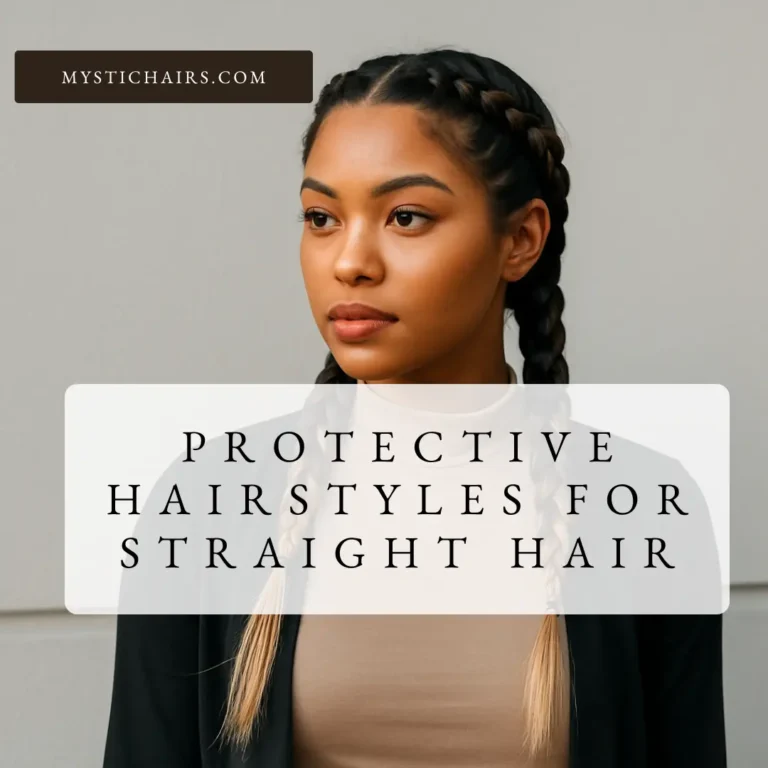How to Reduce Frizz in Hair: Expert Guide for Smooth, Shiny, and Manageable Hair
How to reduce frizz in hair is a question asked by women of all ages because frizz can completely change how your hair looks and feels. Frizz often occurs when the outer layer of your hair (the cuticle) becomes rough, raised, or damaged, allowing moisture from the environment to penetrate the hair shaft. This causes strands to swell and appear dry, puffy, or unmanageable. For many women, frizz becomes a daily battle, especially in humid conditions, after heat styling, or if hair care routines strip natural oils.
The good news is that you can control frizz effectively with a thoughtful, consistent routine that restores moisture and protects the hair cuticle. The right frizz control techniques involve gentle cleansing, proper hydration, protective styling, and the correct use of products that smooth the hair shaft.
How to Reduce Frizz in Hair
Whether you have curly, wavy, straight, or coily hair, following these tips will make your strands look healthier and more polished over time.
Switch to a Moisturizing, Sulfate-Free Shampoo and Conditioner
Frizz often signals that your hair lacks hydration. Many commercial shampoos contain sulfates, which are harsh detergents that remove natural oils. This makes your hair dry and rough, leaving it more prone to frizz. Switching to a sulfate-free shampoo helps you cleanse your scalp and hair gently without over-drying. Hydrating shampoos with ingredients like argan oil, shea butter, glycerin, or aloe vera are excellent for retaining moisture.
After shampooing, always follow with a moisturizing conditioner. A good conditioner smooths down the cuticle and replenishes hydration lost during washing. When your hair is moisturized and the cuticle is sealed, humidity and environmental factors won’t be able to make it frizzy as easily. This is one of the most important steps for frizz control and smooth hair tips.

Reduce Washing Frequency to Preserve Natural Oils
One of the leading causes of frizz is over-washing. Washing your hair every day may seem refreshing, but it strips away the natural oils that keep strands soft and smooth. Without these oils, the hair cuticle becomes dry and lifted, allowing moisture from the air to penetrate and cause frizz. To combat this, wash your hair two or three times a week instead of daily.
On days when you don’t wash your hair, you can refresh it with a light leave-in conditioner spray or a little natural oil to keep your strands hydrated. This balance helps maintain moisture and strengthens your hair’s ability to resist frizz. Less frequent washing is one of the simplest, yet highly effective, natural remedies for frizz.

Always Use a Wide-Tooth Comb on Wet Hair
Wet hair is fragile and more vulnerable to breakage, which worsens frizz. Avoid using fine-tooth combs or regular brushes when your hair is wet, as these can snag and damage strands. Instead, use a wide-tooth comb to gently detangle. Start at the ends and work your way up toward the scalp, being patient and careful.
For curly or wavy hair types, detangling with your fingers or a comb designed for curls works even better to preserve your hair’s natural texture without creating additional frizz. This gentle handling of wet hair ensures that your cuticle stays smooth and intact.
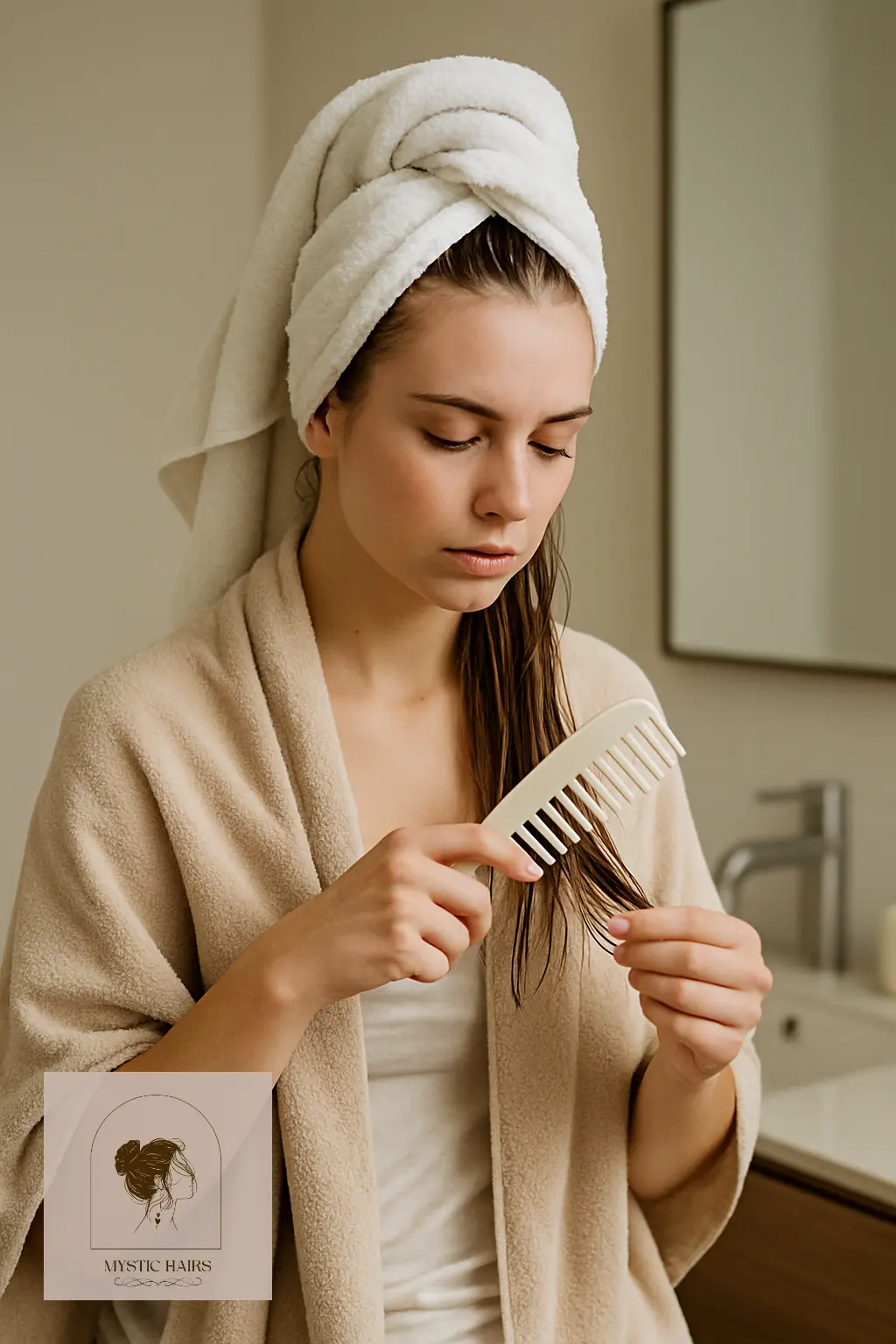
Dry Hair with Microfiber Towels or a Cotton T-Shirt
The way you dry your hair after washing also plays a major role in how frizzy it becomes. Regular towels have a rough texture that can disturb the cuticle, creating static and flyaways. Instead, try blotting your hair gently with a microfiber towel or a soft cotton T-shirt. These materials are much gentler on your strands.
Avoid rubbing your hair with the towel because this creates friction that lifts the hair cuticle. Simply press and squeeze to absorb the water. By changing this simple habit, you’ll see a significant reduction in frizz right from the start of your routine.

Once you’ve tackled frizz, check out these science-backed tips on how to grow your hair faster for longer, healthier strands.
Apply Leave-In Conditioner or Serum to Damp Hair
Leave-in conditioners and smoothing serums act as shields for your hair. After washing and gently drying, apply a leave-in conditioner or anti-frizz serum evenly through the mid-lengths and ends of damp hair. These products coat the hair shaft, add extra moisture, and seal the cuticle, which keeps outside humidity from swelling your strands.
Look for products with nourishing ingredients like argan oil, jojoba oil, keratin, or silicones that smooth the surface of your hair. Regular use of these products forms the base of an effective frizz control routine.

Deep Condition Weekly for Long-Lasting Smoothness
Deep conditioning masks are essential if your hair is prone to dryness and frizz. Once a week, apply a deep conditioner or hair mask that contains natural ingredients like avocado oil, honey, shea butter, and proteins. These treatments penetrate deeply into your hair, repairing damage and replenishing lost moisture.
When your hair is well-nourished, the cuticle remains smooth and less likely to react to humidity or friction. Deep conditioning is a long-term investment in anti-frizz care, as it strengthens your hair and gives it a naturally shiny, healthy look.

Limit Heat Styling and Use Heat Protection Every Time
Heat tools like flat irons, curling irons, and blow-dryers can dry out the hair shaft and make frizz worse over time. Try to limit the use of heat styling tools and opt for air drying or heatless styling techniques whenever possible. Heatless waves, buns, or braids can create beautiful styles without damaging your hair.
If you must use heat, always apply a heat protectant spray or cream first. This protective barrier locks in moisture and prevents excessive heat from raising the hair cuticle, which helps control frizz. Over time, reducing heat exposure can make a huge difference in how smooth your hair feels.
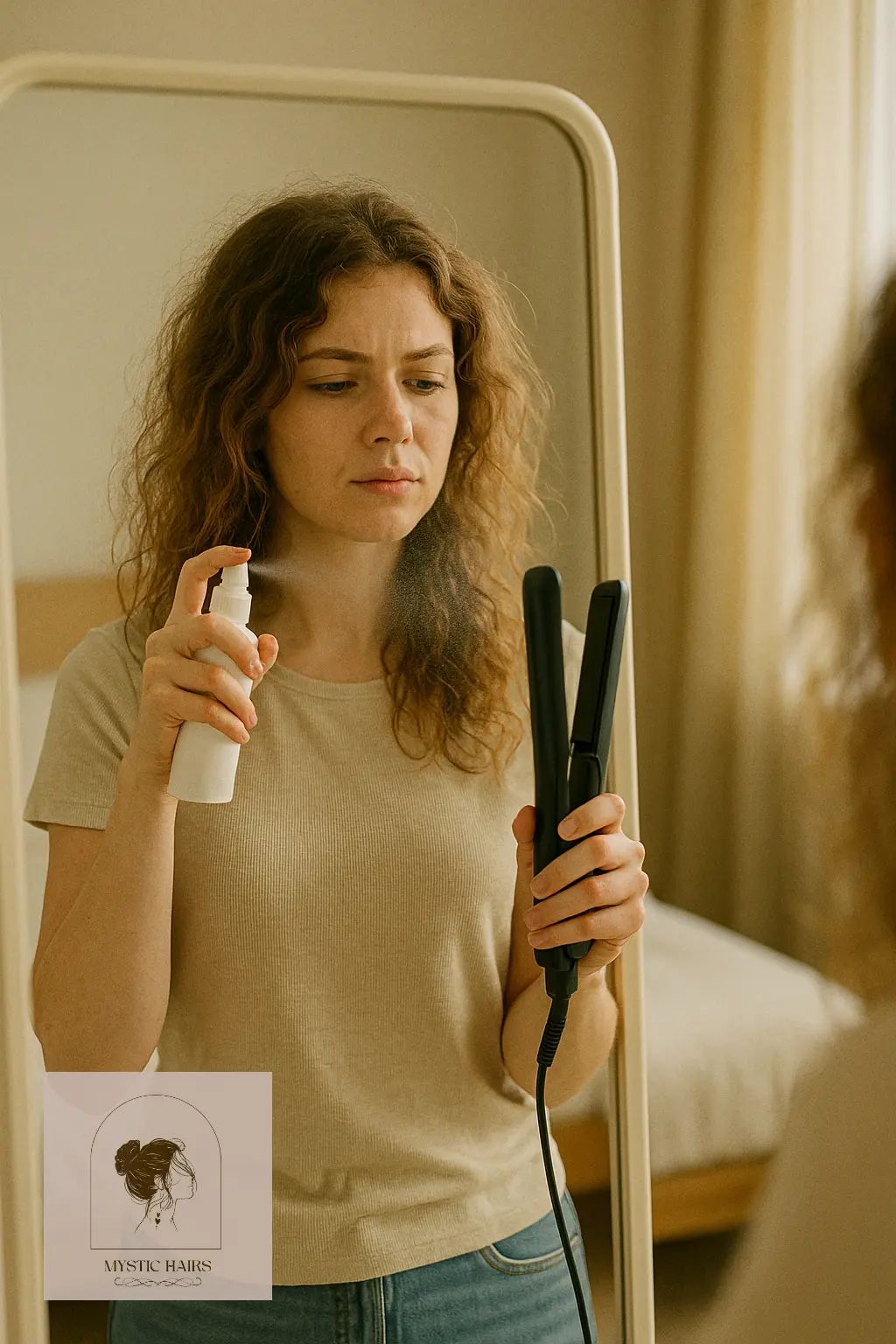
Dealing with frizz doesn’t mean sacrificing style — these best bob hairstyles for round face help maintain shape and smoothness.
Use Cold Water for the Final Rinse
Hot water opens the hair cuticle, which can leave it raised and vulnerable to frizz. After conditioning your hair in the shower, finish with a rinse of cold or cool water. This helps close the cuticle, locking in moisture and creating a smooth surface that reflects light.
This step may seem simple, but it has an immediate effect on how shiny and manageable your hair looks once it dries. Cold water rinsing is an easy, no-cost addition to your smooth hair care routine.
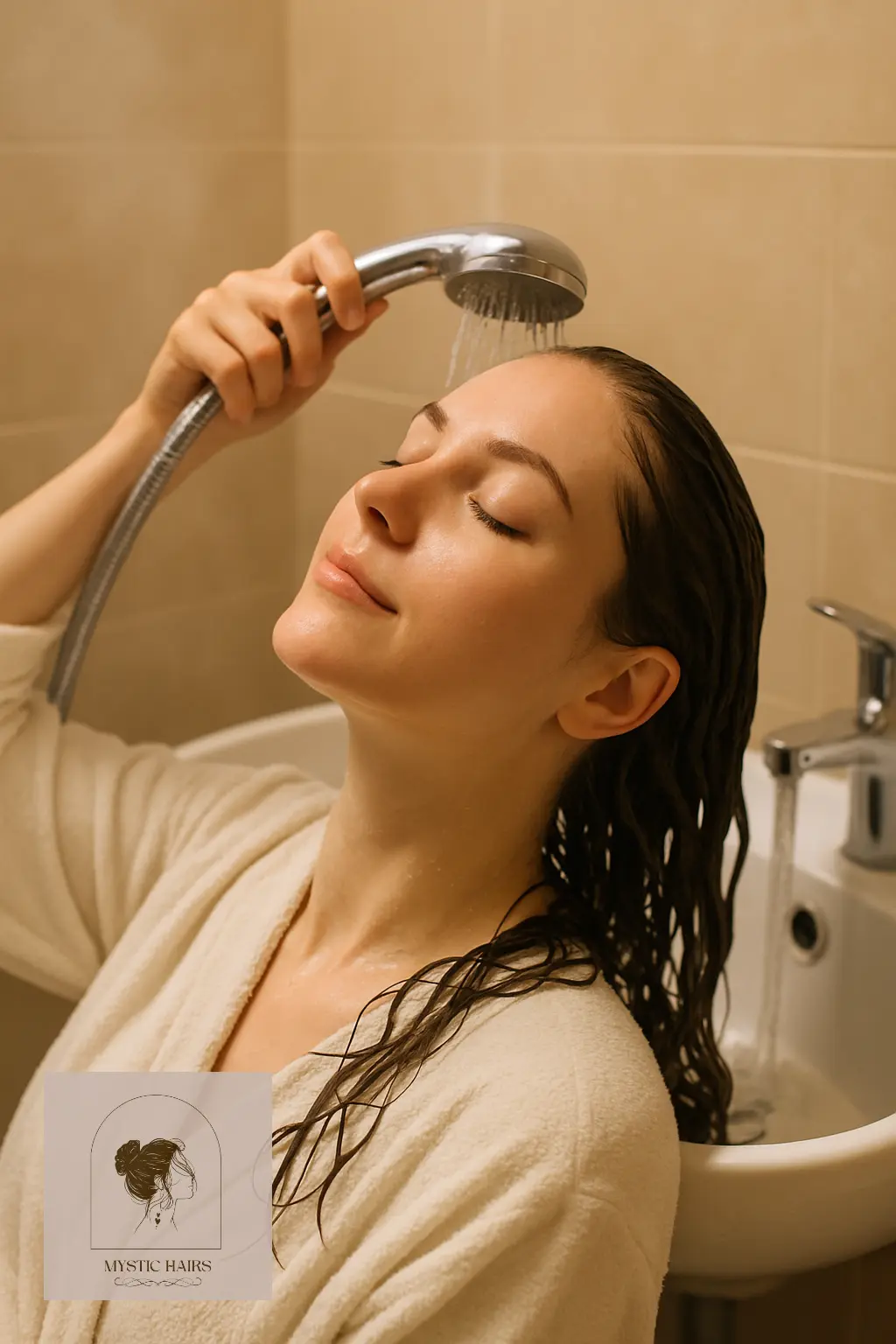
Sleep on Silk or Satin Pillowcases
Your pillowcase can affect how smooth your hair looks when you wake up. Traditional cotton pillowcases create friction as you move around in your sleep, causing tangles, frizz, and breakage. Switching to a silk or satin pillowcase dramatically reduces this friction.
These smooth fabrics also help your hair retain natural oils overnight. Pairing this with loosely braiding your hair or wrapping it in a silk scarf can protect it even more. This step ensures that when you wake up, your hair feels softer and looks less frizzy.

Protect Hair from Humidity
Humidity is a major trigger for frizz because it swells the hair shaft. To protect your hair, use anti-humidity sprays or creams that form an invisible barrier around your strands. These products stop moisture in the air from raising your cuticle.
On days when the air is particularly humid, wear protective hairstyles such as braids, buns, or sleek ponytails. These styles minimize exposure to the elements and keep your hair in place, giving you greater control over your look.
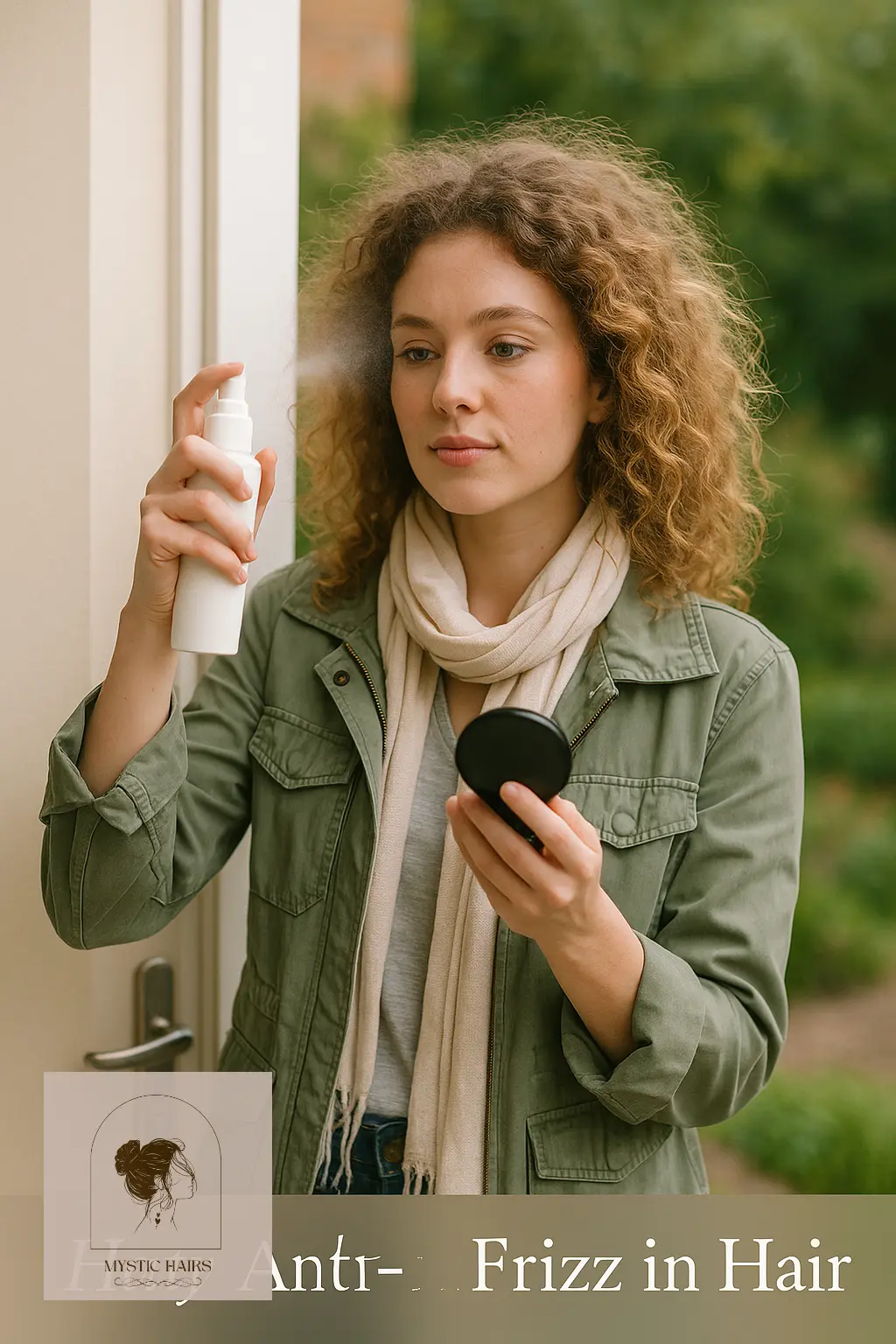
Trim Split Ends Regularly
Split ends are one of the most common causes of frizz and roughness in hair. When the ends of your hair are damaged, the cuticle becomes uneven and frays, making the entire strand look frizzy. Getting a trim every 8 to 10 weeks is essential to maintain smooth, healthy hair. Regular trims remove the oldest, most damaged parts of your hair, preventing the split from traveling upward and causing further breakage.
This simple habit doesn’t just make your hair look neat; it also makes it easier to manage. Even if your goal is to grow longer hair, trimming is a vital part of frizz control. Removing frayed ends allows your hair to retain moisture more effectively and creates a polished, smooth appearance that looks healthier in every style.
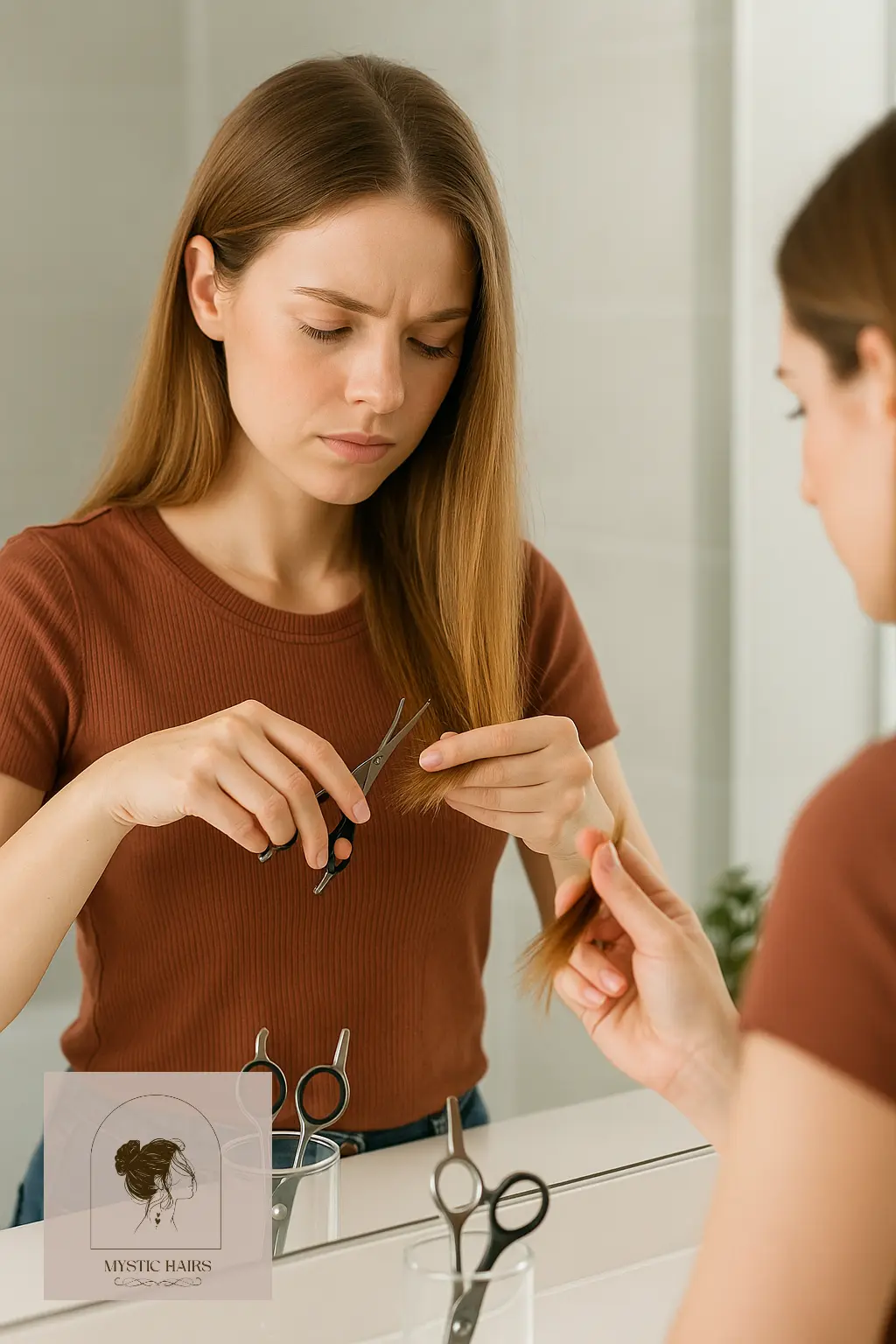
Use Natural Oils to Seal and Smooth Strands
Natural oils like argan oil, coconut oil, jojoba oil, almond oil, and marula oil work as natural remedies for frizz. After styling, applying a few drops of lightweight oil to the mid-lengths and ends of your hair helps seal in moisture and gives your strands a sleek, shiny finish. Oils are excellent for smoothing the hair shaft because they fill in the gaps along the cuticle, creating a softer, silkier texture.
In addition to post-styling application, you can also do oil treatments once a week, leaving oils on your hair for 30 minutes or overnight before washing. This deep nourishment strengthens your hair from within while forming a protective barrier against humidity and dryness. Over time, natural oils help you maintain a smooth hair care routine without relying heavily on chemical products.

Combat humidity with sleek brown bob hairstyles that minimize frizz and maximize elegance.
Avoid Alcohol-Based and Harsh Styling Products
Many gels, hairsprays, and mousses contain high levels of alcohol that can dry out your hair. Dryness raises the hair cuticle and results in frizz, making your styling efforts less effective. Instead, choose alcohol-free anti-frizz products that provide hold and smoothness while keeping moisture locked in.
Read labels carefully before purchasing styling products. Ingredients like aloe vera, plant-based oils, or keratin can help control frizz without stripping moisture. Switching to gentler styling formulas is a subtle but powerful frizz control tip that improves hair quality in the long run.
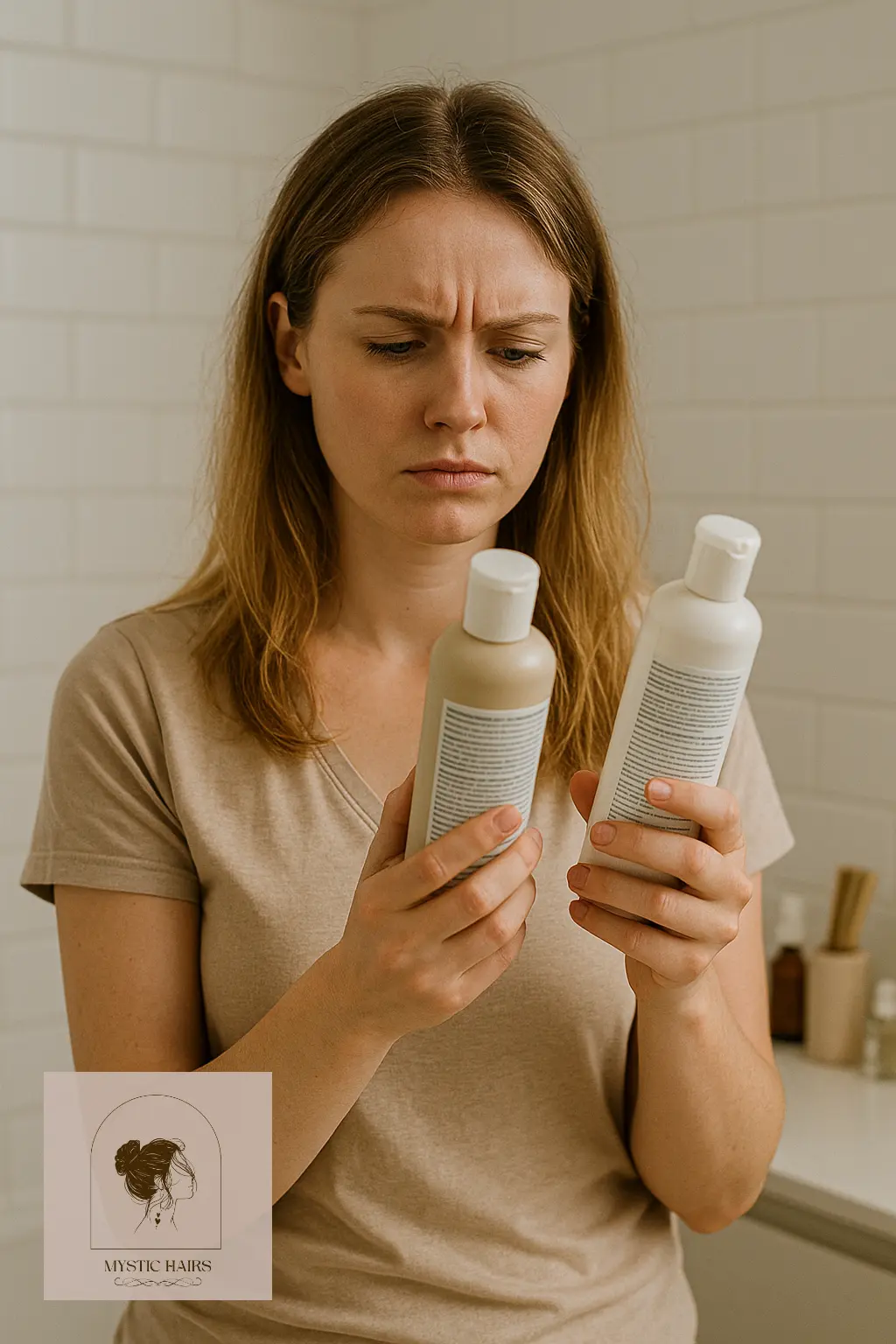
Manage Stress for Healthier Hair
Stress affects your entire body, including your hair. High stress levels can lead to hormonal imbalances that impact the health of your scalp and hair follicles. This often results in hair that appears dull, dry, and more prone to frizz. To keep your hair and scalp healthy, make stress management a part of your hair care routine.
Incorporate calming activities such as yoga, meditation, deep breathing exercises, journaling, or regular walks. A relaxed mind helps balance the body’s systems, including the scalp environment. When your internal health is stable, your hair becomes stronger, smoother, and easier to maintain, enhancing the effects of natural remedies for frizz.

Build Consistency and Patience Into Your Hair Routine
Perhaps the most essential piece of advice in learning how to reduce frizz in hair is consistency. None of these tips are quick fixes; they work best when practiced regularly. A good anti-frizz hair care routine involves hydration, gentle handling, protective styling, and proper nutrition, all applied consistently over weeks and months.
Over time, you’ll notice significant improvements in how your hair looks and feels. Frizz will become less noticeable as your strands become healthier and more resilient. Patience and daily care are what transform hair from frizzy and unruly to smooth, silky, and full of life.

Final Note
How to reduce frizz in hair is about more than just using one product—it’s a lifestyle approach that focuses on moisture, protection, and care. By combining these frizz control techniques—like using sulfate-free shampoos, weekly deep conditioning, applying natural oils, trimming regularly, and managing stress—you can drastically improve the smoothness and manageability of your hair.
The right anti-frizz products and consistent habits create long-lasting results. Whether you have naturally straight, wavy, curly, or textured hair, these methods help restore shine, reduce flyaways, and leave your hair soft and polished. With a little dedication, frizz will no longer define your look; instead, your hair will reflect the health and attention you put into it every day.

Aria Blake is a beauty writer and hairstyle curator passionate about empowering women through timeless trends and modern haircare. With a deep love for natural textures and creative styling, Aria blends expert tips with real-life inspiration to help you look and feel your best—every single day. When she’s not writing for MysticHairs.com, you’ll find her exploring protective styles, sipping herbal tea, or pinning dreamy looks for your next hair glow-up.

